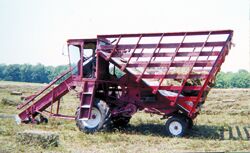
Finding help to retrieve small square bales in the field was getting to be nearly impossible for David Arledge, Chillicothe, Ohio. So he came up with a totally new machine that picks up the bales, hauls them home, and then unloads quickly. It lets him get bales into the barn by himself.
"I got the idea one day while looking at an IH 303 combine. It suddenly hit me that it would make an excellent self-propelled bale handling wagon," says Arledge.
To convert the combine, he removed the engine, grain tank and all threshing components, but left the cab in place. Next, he cut the frame apart and lengthened it about 18 in.
Behind the cab he built a 10-ft. wide by 12-ft. long bed that slopes toward the back of the machine. The bed consists of a piece of Cortex, plywood sheeting covered with a thin layer of sheet metal. He added 8-ft. high sides to the bed using 4 by 4 treated posts that support 2 by 6 rails. A tailgate hinged at the top swings open like the tailgate on a dump truck.
To power the bale wagon, he remounted the engine in front of and slightly underneath the cab. "I made engine mounts from a couple of lengths of I-beam that I mounted over the top of the axle," he says. With no need for a header on the old combine frame, there was plenty of room there and he was able to use the same belts that originally drove the combine.
In an effort to keep engine heat out of the cab and prevent hay chaff and dirt from clogging the radiator, Arledge replaced the original fan with a reverse fan, which blows air away from the engine rather than into it.
To load bales into the sloping bale box, Arledge started with an old grain elevator. "It was a 40-ft. chain-type elevator with paddles. I cut off about 20 ft. and fitted it with a single chain designed for use with bale elevators. Rather than paddles, it has short forks that grab onto bales."
He ran the chain through a 3-ft. flexible extension he built and attached to the top of the elevator. The extension can be raised or lowered according to the height of the load. "When the box is empty, I lower the extension so the bales don't drop as far, reducing breakage," he says. "As it fills, I raise it up so it drops bales on top of the load."
The elevator mounts at the center of the machine, to the right of the cab.
The lower end of the elevator mounts on four rubber wheels. He used two 10-in. wheels right under the elevator, with two smaller wheels attached further forward mounted about 4 in. off the ground. That way, they catch and raise the front of the elevator if the rear wheels drop into a depression or rut.
Bales are guided into the elevator by a couple of leaf springs.
He raises and lowers the elevator with the header cylinder. He found an old hydraulic motor and geared it down with pulleys so it turns the elevator at the right speed.
He says the box holds 65 to 70 bales. When it's full, he drives to the hay barn and opens the tailgate. "They slide out because the floor is slanted and slick," he says. "My barn holds more hay than I can use, so I usually don't bother stacking the bales. I just run them up the elevator and let them drop. With this system, I only have to handle the hay once - when I put the bales on the elevator."
